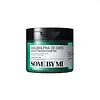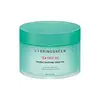What's inside
What's inside
 Key Ingredients
Key Ingredients

 Benefits
Benefits

 Concerns
Concerns

 Ingredients Side-by-side
Ingredients Side-by-side

Salix Alba Bark Water 85%
AstringentButylene Glycol
Humectant1,2-Hexanediol
Skin ConditioningGlycerin
HumectantSodium Hyaluronate
HumectantBetaine Salicylate 0.5%
AntimicrobialArtemisia Princeps Leaf Extract
Skin ConditioningCentella Asiatica Extract
CleansingMelaleuca Alternifolia Leaf Water
AntimicrobialChamaecyparis Obtusa Leaf Extract
Skin ConditioningOpuntia Ficus-Indica Extract
Skin ConditioningHouttuynia Cordata Extract
Skin ConditioningMelia Azadirachta Leaf Extract
Skin ConditioningMelia Azadirachta Flower Extract
Skin ConditioningMadecassic Acid
Skin ConditioningAsiaticoside
AntioxidantAsiatic Acid
Skin ConditioningMadecassoside
AntioxidantAllantoin
Skin ConditioningPanthenol
Skin ConditioningArginine
MaskingPEG-60 Hydrogenated Castor Oil
EmulsifyingCitric Acid
BufferingLactobionic Acid
BufferingSodium Hydroxide
BufferingWater
Skin ConditioningBenzyl Glycol
SolventEthylhexylglycerin
Skin ConditioningRaspberry Ketone
MaskingMentha Piperita Oil
MaskingSalix Alba Bark Water 85%, Butylene Glycol, 1,2-Hexanediol, Glycerin, Sodium Hyaluronate, Betaine Salicylate 0.5%, Artemisia Princeps Leaf Extract, Centella Asiatica Extract, Melaleuca Alternifolia Leaf Water, Chamaecyparis Obtusa Leaf Extract, Opuntia Ficus-Indica Extract, Houttuynia Cordata Extract, Melia Azadirachta Leaf Extract, Melia Azadirachta Flower Extract, Madecassic Acid, Asiaticoside, Asiatic Acid, Madecassoside, Allantoin, Panthenol, Arginine, PEG-60 Hydrogenated Castor Oil, Citric Acid, Lactobionic Acid, Sodium Hydroxide, Water, Benzyl Glycol, Ethylhexylglycerin, Raspberry Ketone, Mentha Piperita Oil
Melaleuca Alternifolia Leaf Extract
PerfumingWater
Skin ConditioningCentella Asiatica Extract
CleansingButylene Glycol
HumectantMelaleuca Alternifolia Leaf Water
Antimicrobial1,2-Hexanediol
Skin ConditioningMelaleuca Alternifolia Flower/Leaf/Stem Extract
Skin ConditioningBetaine
HumectantDipropylene Glycol
HumectantHydroxyacetophenone
AntioxidantAllantoin
Skin ConditioningPanthenol
Skin ConditioningMelaleuca Alternifolia Leaf Oil
AntioxidantCarbomer
Emulsion StabilisingPolyglyceryl-10 Laurate
Skin ConditioningXanthan Gum
EmulsifyingArginine
MaskingDisodium EDTA
Ethylhexylglycerin
Skin ConditioningCapryloyl Salicylic Acid
Exfoliating4-Terpineol
MaskingMelaleuca Alternifolia Leaf Extract, Water, Centella Asiatica Extract, Butylene Glycol, Melaleuca Alternifolia Leaf Water, 1,2-Hexanediol, Melaleuca Alternifolia Flower/Leaf/Stem Extract, Betaine, Dipropylene Glycol, Hydroxyacetophenone, Allantoin, Panthenol, Melaleuca Alternifolia Leaf Oil, Carbomer, Polyglyceryl-10 Laurate, Xanthan Gum, Arginine, Disodium EDTA, Ethylhexylglycerin, Capryloyl Salicylic Acid, 4-Terpineol
 Reviews
Reviews

Ingredients Explained
These ingredients are found in both products.
Ingredients higher up in an ingredient list are typically present in a larger amount.
1,2-Hexanediol is a synthetic liquid and another multi-functional powerhouse.
It is a:
- Humectant, drawing moisture into the skin
- Emollient, helping to soften skin
- Solvent, dispersing and stabilizing formulas
- Preservative booster, enhancing the antimicrobial activity of other preservatives
Allantoin is a soothing ingredient known for its protective and moisturizingg properties. Because of this, it is often added to products with strong active ingredients.
Studies show higher concentrations of this ingredient can promote wound healing.
Though it can be derived from the comfrey plant, allantoin is produced synthetically for cosmetic products to ensure purity.
Learn more about AllantoinArginine is an amino acid that is important for human development. Your body uses is it to produce hair keratin and skin collagen.
As a cosmetic ingredient, Arginine has antioxidant properties and can also help repair damaged skin. This ingredient is derived either synthetically or from animals.
Arginine isn't fungal acne safe when used in the presence of other lipids (fats, fatty acids, oils, esters, etc). Oils and fats occur naturally within the skin, so take caution when using Arginine if you're prone to fungal acne.
Learn more about ArginineButylene Glycol (or BG) is used within cosmetic products for a few different reasons:
Overall, Butylene Glycol is a safe and well-rounded ingredient that works well with other ingredients.
Though this ingredient works well with most skin types, some people with sensitive skin may experience a reaction such as allergic rashes, closed comedones, or itchiness.
Learn more about Butylene GlycolCentella Asiatica Extract (Centella) is derived from an herb native to Southeast Asia. It is famous for its anti-inflammatory and soothing properties.
Centella is rich in antioxidants and amino acids, such as Madecassic Acid and Asiaticoside.
Studies show the compounds in centella help with:
The combination of all these properties makes centella effective at soothing, hydrating, and protecting the skin.
Other great components of centella include Vitamin A, vitamin C, several B vitamins, and Asiatic Acid.
Fun fact: Centella has been used as a medicine and in food for many centuries. As a medicine, it is used to treat burns, scratches, and wounds.
Learn more about Centella Asiatica ExtractEthylhexylglycerin (we can't pronounce this either) is commonly used as a preservative and skin softener. It is derived from glyceryl.
You might see Ethylhexylglycerin often paired with other preservatives such as phenoxyethanol. Ethylhexylglycerin has been found to increase the effectiveness of these other preservatives.
This ingredient is created by distilling parts of the tea tree plant. The bark and leaves of the tea tree plant are rich in Terpinen, an antioxidant, antibacterial, and anti-inflammatory ingredient.
Tea tree may cause sensitivity and irritation for some people due to its linalool and limonene content.
Learn more about tea tree benefits here.
Learn more about Melaleuca Alternifolia Leaf WaterPanthenol is a common ingredient that helps hydrate and soothe the skin. It is found naturally in our skin and hair.
There are two forms of panthenol: D and L.
D-panthenol is also known as dexpanthenol. Most cosmetics use dexpanthenol or a mixture of D and L-panthenol.
Panthenol is famous due to its ability to go deeper into the skin's layers. Using this ingredient has numerous pros (and no cons):
Like hyaluronic acid, panthenol is a humectant. Humectants are able to bind and hold large amounts of water to keep skin hydrated.
This ingredient works well for wound healing. It works by increasing tissue in the wound and helps close open wounds.
Once oxidized, panthenol converts to pantothenic acid. Panthothenic acid is found in all living cells.
This ingredient is also referred to as pro-vitamin B5.
Learn more about PanthenolWater. It's the most common cosmetic ingredient of all. You'll usually see it at the top of ingredient lists, meaning that it makes up the largest part of the product.
So why is it so popular? Water most often acts as a solvent - this means that it helps dissolve other ingredients into the formulation.
You'll also recognize water as that liquid we all need to stay alive. If you see this, drink a glass of water. Stay hydrated!
Learn more about Water